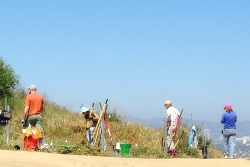is in the air and with the warm weather comes a renewal at the Baldwin Hills scenic overlook.
Baldwin Hills Conservancy, in partnership with Generation Water, Council for Watershed Health and Mujeres de la Tierra have begun a restoration project to identify, map and remove invasive plants and restore native vegetation to the Baldwin Hills Conservancy territory.
The Habitat Restoration Project is designed to directly achieve several of the goals of the Baldwin Hills Conservancy including to protect and restore the natural habitat.
The hill was alive with volunteer workers over the Easter weekend, diligently laboring to clear the brush and plant new vegetation. California State Parks Foundation’s Park Champions Program organized the effort.
Culver City resident Cliff Moser, along with his family, was part of the clean up crew.
“We’ve been actively supporting the Baldwin Hills restoration since my son, now almost 16, played Little League in Bill Botts Park many years ago. Before the state improved the site and built the visitor’s center, we used to wander up to the top and imagine what a wonderful overlook destination the top of the hill would be,” said Moser.
There are more than 30 public agencies involved with Baldwin Hills. Those with primary responsibility for the area are the California Department of Parks and Recreation, Los Angeles County Department of Parks and Recreation and the Baldwin Hills Regional Conservation Authority.
Much of the land in public ownership is owned by the state of California and managed by the county of Los Angeles under a long-term operating agreement. The California State Coastal Conservancy plays a role as well, as the area is a critical portion of the Ballona Creek watershed.
A watershed is an area of land within which all precipitation will drain to the same body of water. The Ballona Creek watershed is a part of the Santa Monica Bay watershed.
“Watershed health primarily refers to hydrologic characteristics as well as surface qualities which affect the hydrologic characteristics – erosion, pollution and vegetative cover all affect the water quality, and can impact infiltration, percolation, release and evaporation,” said Rebecca Shields Moose, Generation Water manager for Habitat Restoration.
The Council for Watershed Health has played an important role in the development and implementation of the project.
Council staff, John Tangenberg and Jason Casonova, has worked with Generation Water to plan and implement a Geographic Information System based invasive plant mapping program.
GIS is a system designed to capture, store, analyze and manage all types of geographical data.
Sustainable Landscape Program Manager, Drew Ready initiated the development of a technical advisory committee to determine high priority and easily accessible habitat restoration sites.
Invasive plant species can overrun the land and cause havoc with wildlife and other native plants.
“Landscaped areas are not habitat, and require maintenance to keep their appearance, which is cultivated for a purpose. Areas of native habitat typically require 3 to 10 years of regular work to establish natives and control invasives, before the habitat is well established,” said Moose.
“Once established, ideally the follow-up work is greatly reduced, requiring only small efforts to continue to keep the invasive species under control at edges and areas of disturbance.”
Pampas grass received attention during the flowering season. While all the plants could not be removed in time to prevent another season of growth and flowering, the team collected every flowering stalk in the park.
“Invasive plants are experts at monopolizing water, sunlight and other resources, preventing other plants from thriving or even growing,” said Moose.
“Some species of invasive plants will require large scale efforts if they gain a foothold further down the road, and some species will require significant efforts for many years before they are considered eradicated.”
Ready, a former nursery manager, helped get a native plant propagation greenhouse up and running.
“Native plants are pushed aside, and without the animal and insect habitat they provide those species can go locally extinct. Native ecosystems also improve watershed health and reduce fire hazards,” said Moose.
The council also worked closely with ecologist Dan Cooper to develop an invasive plant management plan framework. This plan is being finalized and will include 10 sites and restoration protocols for high priority areas.
“We volunteered by weeding on Saturday through the volunteer efforts of the California State Parks Foundation. We’ve been members of this organization for a number of years now. My family participated in a planting session last fall as well,” said Moser.
The team also worked on the infestation along La Cienega Boulevard.
“I am a serial volunteer, and have worked with Friends of the Los Angeles River, Ballona Creek Wetlands, LAX Advisory Committee and countless other groups over the years. I think it is important to volunteer, because it adds meaning to our lives and gets us out into communities and opportunities where we can reflect on how we matter to each other as people and society,” said Moser.
This ongoing project needs volunteers.
“We typically have a minimum of 60 volunteers at our events, and always have room for more. A key purpose of the community building effort is to build a sustained and engaged volunteer program to continue efforts to restore the Baldwin Hills Park Lands,” said Moose.
“For genuine long-term success in habitat restoration, there will need to be stewards who continue this work for generations to come, and the community will have to understand the importance of the work and the benefits of strengthened native habitat to support and protect those continued efforts.”
If you are interested in volunteering, email Rebecca Shields Moose at rebecca@generationwater.org for dates and details.













